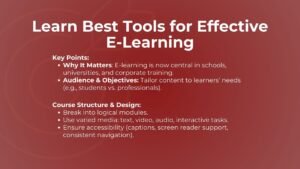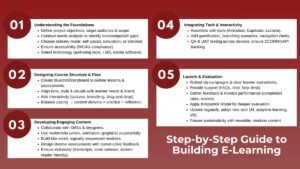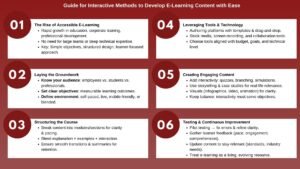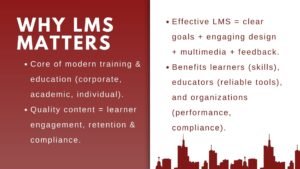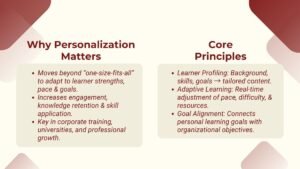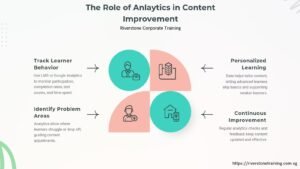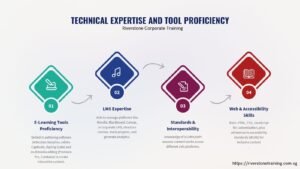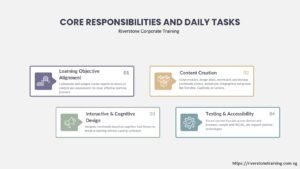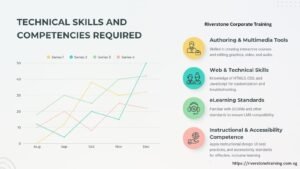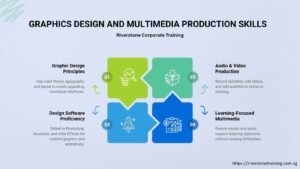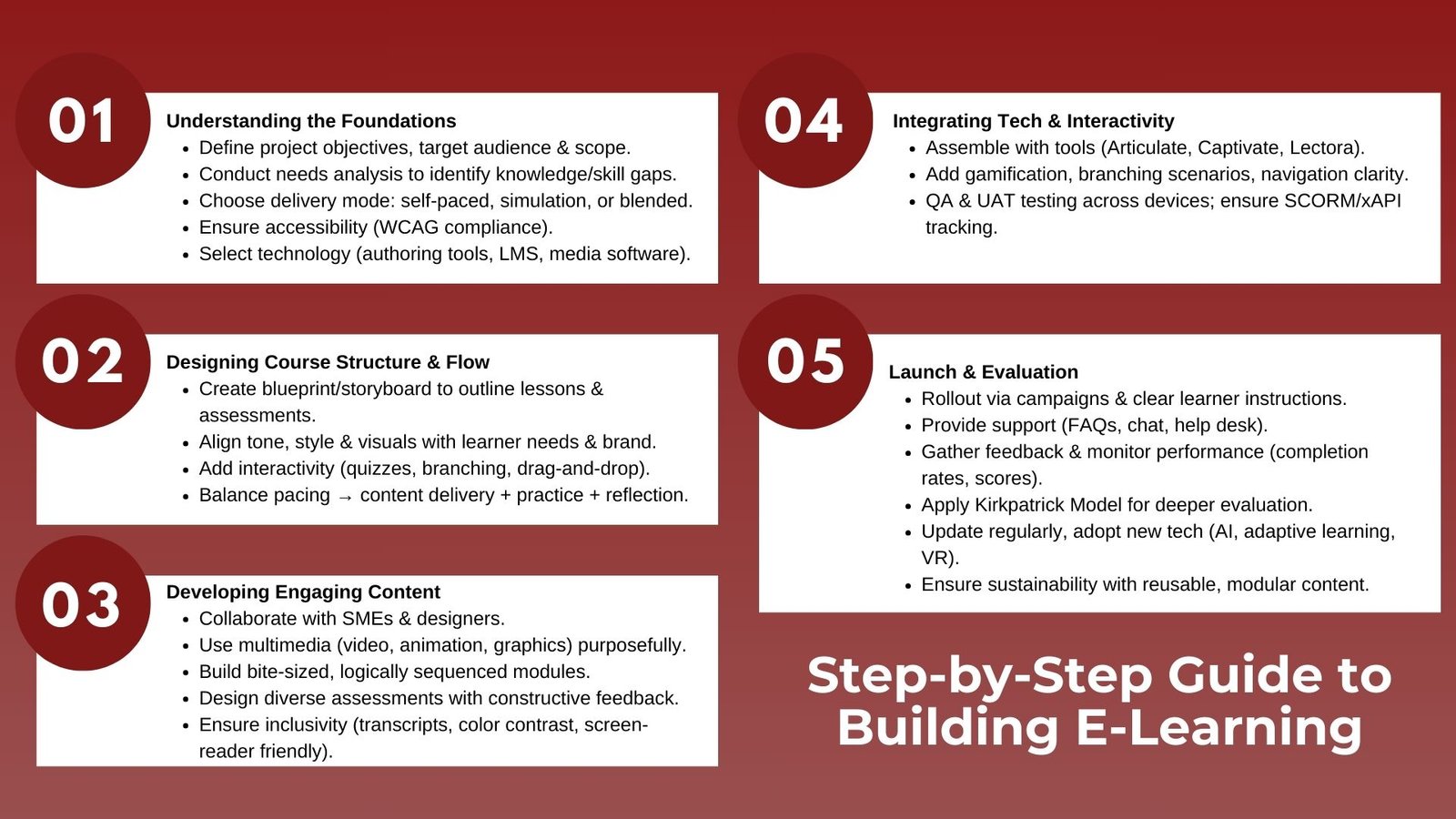
Step by Step Guide to E-Learning Development
Step by Step Guide to E-Learning Development
Understanding the Foundations o fStep by Step Guide to E-Learning Development
E-learning development is an undertaking that integrates instruction design, technology and creativity to establish interesting online learning experiences. Preparation paves ways to any successful e-learning experience and this is done by clearly defining objectives of the project, target audience and mode of delivery. Project teams will have to define the learning objectives and how all those can integrate with the bigger picture of the entire organization before they get down to designing one of their numerous screens or even recording one of their numerous videos.
This phase is usually characterised by carrying forward a needs analysis to identify knowledge or skill gaps and whether an e-learning solution is the suitable proposal and defining the project scope. Organizations often collaborate with Interactive e-learning content creators Singapore to ensure these objectives align with engaging and effective digital delivery.
After defining goals, one has to define the instructional strategy. This includes determining what kind of learning experience, is it going to be a self directed course, interactive simulation or blended format which will include some instructor delivered components. The background of the target audience, its learning attitudes and skills regarding technologies, also determine the course design to a great extent. The accessibility, including the WCAG requirements, should be considered at the very beginning so that the learners could be able to take part in the learning process with equal opportunities.
Another important aspect at this stage is to select an appropriate technology platform. Authoring tools, media production software and Learning Management Systems (LMS) must be chosen depending on the form the content will take, the degree of interactivity it may need, and the expansion (or gradation) of the program. Early stabilization of these basic components helps in avoiding a redesign phase later in the process that organizations must incur as a result of lack of integration in the first phase of development.
Designing the Course Structure and Flow
Upon getting the foundation anchored, the variety of activities can be carried out by developing the design of course structure. It is based on working out a blueprint, which should detail how the information flows, in which order lessons are taught and how assessments are incorporated. A well known way to know each screen, interaction, and media before starting the production is called storyboarding. This phase will enable the instructional designers to conceptualize the presentation of the content and the possible areas of engagement, including quizzes, branching scenarios, or the case study.
The design stage is also involved in the establishment of tone and style of the course. Design decisions (including color schemes, typography and iconography) should reflect the brand identity but lead to ease of reading and comfort of the learners. Simultaneously, this can be the use of the narrative voice and the language style that should be oriented toward either the formal and academic, and conversational and friendly audience.
One of the significant components in maintaining the interest of learners is interactivity. Learners ought to be urged to make decisions, follow content paths and use their knowledge in simulated environments as opposed to being passive recipients of information. This can be drag-and-drop, scenario questions or timelines. The course pacing is an aspect that would require serious consideration keeping in mind content delivery versus practice and reflection opportunities.
Developing Engaging and Relevant Content
The content development phase converts course design to real learning materials. Subject matter experts (SMEs) and instructional designers also work hand in hand, to ensure the course and information is correct, relevant and to the learning goals. Subject matter ought to be structured as bite sized items in order to avoid mental fatigue and every course ought to follow a logical progression to the previous course.
Additions of multimedia like videos, animation, graphics and audio narration can improve the awareness of a topic and particularly in a complex subject matter. Nonetheless, these aspects ought to be incorporated with a purpose and not as a distraction. Online technologies, such as video content, must be to the point, well scripted, and aesthetic in terms of fitting within the rest of the course. The process or abstract idea can be explained by means of animations, whereas, the relations between the ideas can be presented through the static visual (e.g. diagram, chart).
Another issue that is developed when working with content is assessment design. Knowledge checks, quizzes and end-of-module tests will not only assess the progress that the learners have made but also make it possible to consolidate the most important points. Assessment methods too, should be diverse in nature, be it multiple choice questions or open problems, to get the respondents to think more. The feedback process ought to be constructive and immediate and help the learners on the correct path in understanding things without instilling demoralization.
Easy access is a concern of content setup. This implies the need to provide transcripts of videos, to make the text screen-reader friendly, and to take into consideration the color contrast of its design. E-learning developers increase the scope and impact of their courses by designing them as inclusively as possible.
Integrating Technology and Interactivity
Once the development of content is done, the next step is to incorporate the same into the desired technology platform. The step needs to have technical expertise in order to make the course work easily with various devices and browsers. Currently, authoring tools like Articulate Storyline, Adobe Captivate or Lectora are frequently deployed in assembling the course, which in turn integrates text, multimedia and interactivity into a harmonized learning journey.
Interactivity features are programmed or written in this stage. Branching scenarios demand conditional logic that takes learners through one path or another according to the decisions they make. To enhance the level of motivation, gamification elements can be put in place including points, badges, leaderboards. Easy to navigate controls should be taken into consideration where learners can navigate the course without any confusion.
At this stage, testing is very critical. Quality assurance (QA) testing has to be done by developers who have to clear all the technical bugs, dead links, and formatting errors. The course must also be tested across several devices i.e. the desktops, tablet and smart phones to have responsive design. With a limited number of learners, user acceptance testing (UAT) can give insights on usability, clarity and engagement prior to launching the official version.
The tracking of data should be incorporated as part of the course to understand progress and performance. This may include SCORM compliance or xAPI to achieve detailed analytics including time flow on each module, quiz score and interaction pattern. These insights also assist in gauging how well the training has been carried out and where the organizations can improve.
Launching the E-Learning Course and Driving Engagement
After the course has undergone testing, it is to be launched. The roll out strategy will require differences on the needs of the organization. Certain e-learning applications are issued to the whole population at the same time, whereas others are phased and the first group is narrowed down to the specific groups. The most important aspect of promoting participation is to announce the launch. This can be in the form of internal marketing campaigns, email reminders, or being incorporated into pre-existing turnover reduction programs in the employing of employees.
It is important to introduce clear instructions into the system to enable learners to use the course and navigate it without frustration and requests for technical support. Support channels like help desks, frequently asked questions(FAQs), or chats can be created that should help users with any problem they have.
It does not stop when the launch is made. The course should highly be promoted by the organizations during its span of availability via incentives or recognition programmes to complete it. Survey or discussion forums on physics are optimal to collect learner feedback, which can be used to identify the strong and weak aspects of the course. The insights do not only enhance the existing program but also convey the design of e-learning efforts in the future.
Measuring the rate of participation, the results of assessment, and the satisfaction of learners give the whole picture of the effectiveness of the effects of the program. It is possible to revise the modules that are less engaging or have low rates of comprehension, to make them more effective. The cycle of continuous improvements is necessary because it will keep e-learning relevant and very influential.
Evaluating and Evolving E-Learning Initiatives
Evaluation is the process of e-learning development. Despite the measurement of the success of the program, its quantitative and qualitative data are analyzed. Some quantitative measures may be completion rates, the average score on quizzes and the time taken to complete. Learners and stakeholders can give qualitative feedback that may give an idea about perceived relevance, ease of use, and general satisfaction. Interactive online finance & investment learning courses often integrate such evaluation metrics to ensure learners gain measurable value.
Such evaluation models as the Kirkpatrick Model will help to evaluate the results of the learning process at three or more levels, including the reaction of the learners, their changes in behavior as a result of learning, and the overall organizational outcomes. In case the training was necessary to enhance certain performance indicators, e.g. sales volumes, compliance rates, customer satisfaction ratings, they should be monitored both prior and after the initiation to ascertain the scales of influence. This is especially relevant when applying frameworks in an E-learning economics and finance course Singapore to track learner and organizational performance.
E-learning does not remain the same, it should be dynamic with the changes taking place in the organization, in terms of technology and the expectation of the learners. A review of the content, design and delivery platform on a periodic basis makes the course to be defunct. Updates may be required due to outdated examples, outdated technology, or change of the regulations. Personalization and engagement can be increased by adapting some emerging tools like artificial intelligence, adaptive learning systems and virtual reality.
The other major consideration is sustainability. Production of reusable content and modular course materials enables organizations to remodel speedily (not having to start all over again). The principles of setting up feedback loops between the learners, instructors, and developers make sure that the necessary improvements are provided on a continuous basis keeping the e-learning program in touch with its aims and the needs of the audience.



